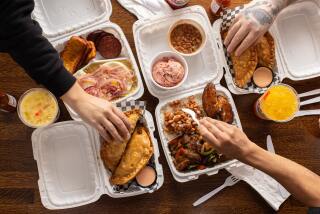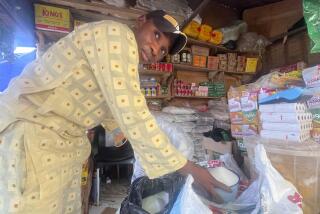Seeking to Diversify as World Prices Remain Depressed : Dominican Company Battles Slump in Sugar
- Share via
LA ROMANA, Dominican Republic — When the going got tough, Gulf & Western Industries got out. It sold off its Dominican subsidiary, the largest private company in the country, and said adios .
Now, the new owners of the huge enterprise are struggling to keep it afloat as world prices for the company’s main product, sugar, sag far below the cost of production.
Jose and Alfonso Fanjul, Cuban-American brothers who live in Palm Beach, Fla., bought the Dominican interests of G&W; in January and changed the name of the company from Gulf & Western Americas to Central Romana.
The purchase included 90,000 acres of valuable sugar land that G&W; owned in Florida. Both companies refuse to disclose the total price, which the Miami Herald has reported at “slightly more than $200 million.”
The Fanjul brothers are scions of an old cane-growing family that moved from Cuba to Florida in 1959, just after Fidel Castro’s revolution. By adding G&W;’s Florida plantations to their previous holdings, they became the biggest sugar-cane growers in Florida.
Sugar Prices Depressed
In the Dominican Republic, they took over a 220,000-acre patchwork of parcels around La Romana, 75 miles east of Santo Domingo. The company produces 32% of all sugar in the Dominican Republic, which is heavily dependent on sugar for export earnings.
The problem for both the company and the country is that world sugar prices have been depressed for the past three years. Last spring, after the G&W; sale to the Fanjuls, the world price dipped to a record low of 2.5 cents a pound. It remains under 5 cents a pound.
Carlos Morales Troncoso, the Dominican president of Central Romana, said its sugar operation is among the most cost efficient in the world. But costs, he said, are still “much higher than the current world market prices.”
Morales, who was also president of the company under G&W; ownership, said that about 100,000 acres of its land is planted in sugar cane. About the same area is set aside for grazing cattle.
The cattle operation produces meat for employees of the company and for sale on the local market, but its main purpose is to produce steers for pulling carts that haul sugar cane. Central Romana uses about 17,000 draft animals during the harvest season. The herd, including breeding stock and calves, totals about 56,000.
Asked why the company does not shift its emphasis from sugar to more profitable beef production, Morales said: “That doesn’t produce employment.”
At the peak of the harvest season, Central Romana employs about 32,000 people and is, aside from the government, the country’s largest employer. The national unemployment rate is estimated at 25% to 30%.
Not all of Central Romana’s operations are in agriculture. About 7,000 of Central Romana’s employees work in its tourism business. The company has two major tourist hotels in Santo Domingo, with a total of 400 rooms, and the Casa de Campo resort hotel at La Romana, with 180 rooms. Last year’s occupancy rate in the hotels was 72%, and company executives expect it to be about 80% this year.
Although Central Romana declines to disclose profit and loss figures, the hotels apparently are its most profitable activities. Morales said the company has decided to invest $16 million in hotel expansion and remodeling.
A new luxury beach hotel with 150 suites, to be called Casa de Mar, will be built at La Romana, and Casa de Campo will be expanded by 50 rooms. Casa de Campo also books hotel guests in hundreds of privately owned vacation villas that the company has built at the 7,000-acre resort site. More villas are being built.
Another non-sugar enterprise that Central Romana plans to expand is a duty-free zone of factory space rented out to foreign companies. The zone has 24 tenants, mostly American companies using low-paid Dominican labor to assemble clothing and electronic products for the U.S. market. They employ 10,000 people. Morales said there are plans for a new zone that will create 10,000 jobs within four years.
Central Romana, like G&W; before it, has experimented with new crops that might be more profitable than sugar. Lime groves on 1,000 acres produce extract and oil for export. Another 1,000 acres is planted in vegetables.
“There is no agricultural company that has tried to diversify more than we have,” Morales said. But he said the company’s lands, in a relatively dry part of the country with marginal soils, are best suited for cane and pasture.
Manuel Vinas, the company’s chief agronomist, said it will continue to look for ways to diversify crops. He said he hopes to plant about 1,000 acres with vegetables for export. And studies are being made for planting orange trees.
Vinas said the company is using a water-saving drip irrigation method on an experimental avocado grove of 50 acres.
“We are going to try it with mangoes, too,” he said. “We have to keep experimenting.”
Meanwhile, the company continues to lose money on its main crop. About 55% of the sugar produced by Central Romana is sold on the world market at a loss. About l5% goes to the Dominican market, also at money-losing prices, and about 30% is sent to the American market under a U.S. quota system that provides attractive preferential prices of about 21 cents a pound. The Dominican quota, however, has been reduced by more than half since 1982.
The Dominican Republic this year exported 420,000 tons of raw sugar to the United States at preferential prices, about 350,000 tons less than the annual amounts shipped from 1977 to 1982.
The preferential price levels make it possible for high-fructose corn syrup to compete on the American market with sugar as an industrial sweetener, even though corn syrup is more expensive to produce. As a result, U.S.-produced corn syrup has occupied a share of the American market previously held by imported cane sugar.
Ten countries in the Caribbean region, including the Dominican Republic, have asked the United States to allow an additional import quota for sugar that would be used as industrial sweetener. The price would be lower than the current preferential price but higher than the world market price.
Central Romana has played an active role in formulating the proposal, which was made in a July 10 letter to Secretary of State George P. Shultz.
More to Read
Sign up for Essential California
The most important California stories and recommendations in your inbox every morning.
You may occasionally receive promotional content from the Los Angeles Times.












